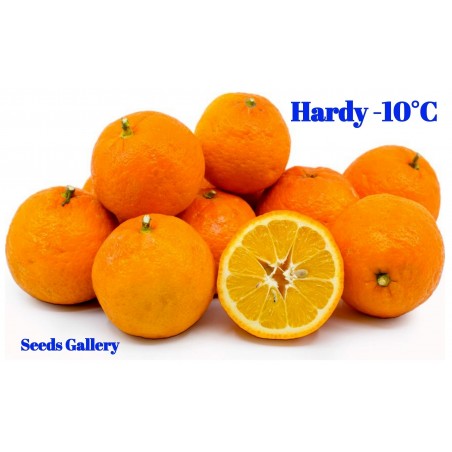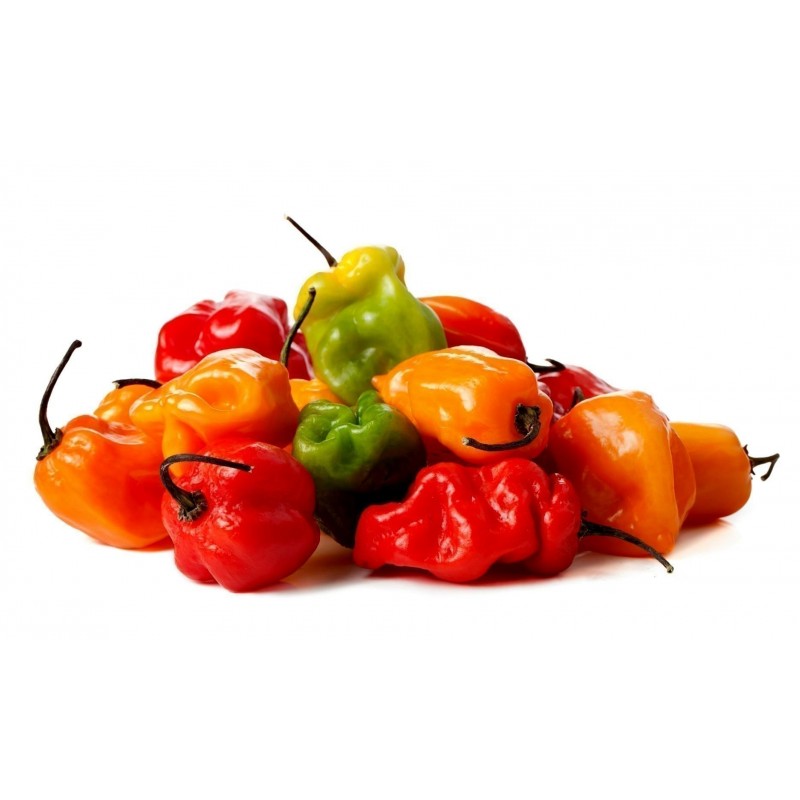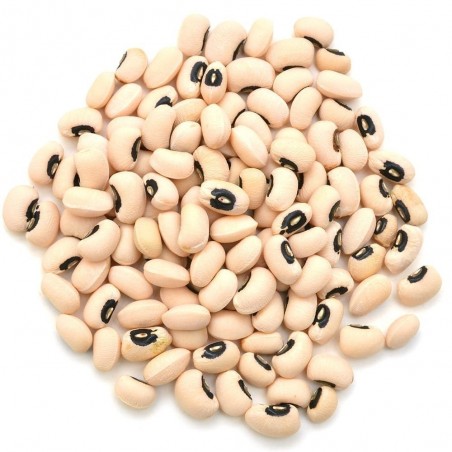
Habanero Red, Yellow, Orange Seeds
Habanero Red, Yellow, Orange Seeds
Price for Package of 10, 20 seeds.
The habanero is a variety of chili pepper. Unripe habaneros are green, and they color as they mature. The most common color variants are orange and red, but the fruit may also be white, brown, yellow, green, or purple. Typically, a ripe habanero chili is 2–6 cm (0.8–2.4 in) long. Habanero chilis are very hot, rated 100,000–650,000 on the Scoville scale. The habanero's heat, its flavor, and its floral aroma have made it a popular ingredient in hot sauces and spicy foods.
The name indicates something or someone from La Habana (Havana). In English, it is sometimes spelled and pronounced habañero, the tilde being added as a hyperforeignism patterned after jalapeño.
Origin and current use
The habanero chili comes from the Amazon, from which it was spread, reaching Mexico. A specimen of a domesticated habanero plant, dated at 8,500 years old, was found at an archaeological site in Peru.[citation needed] An intact fruit of a small domesticated habanero, found in pre-ceramic levels in Guitarrero Cave in the Peruvian highlands, was dated to 6500 BC.
The habanero chili was disseminated by Spanish colonists to other areas of the world, to the point that 18th-century taxonomists mistook China for its place of origin and called it Capsicum chinense ("the Chinese pepper").
Today, the largest producer is the Yucatán Peninsula, in Mexico. Habaneros are an integral part of Yucatecan food, accompanying most dishes, either in natural form or purée or salsa. Other modern producers include Belize, Panama, Costa Rica, Colombia, Ecuador, and parts of the United States, including Texas, Idaho, and California.
The Scotch bonnet is often compared to the habanero, since they are two varieties of the same species, but they have different pod types. Both the Scotch bonnet and the habanero have thin, waxy flesh. They have a similar heat level and flavor. Both varieties average around the same level of pungency, but the actual degree varies greatly from one fruit to another according to genetics, growing methods, climate, and plant stress.
In 1999, the habanero was listed by Guinness World Records as the world's hottest chili, but it has since been displaced by other peppers. The Bhut jolokia (or ghost pepper) and Trinidad moruga scorpion have since been identified as native Capsicum chinense subspecies even hotter than the habanero. Breeders constantly crossbreed subspecies to attempt to create cultivars that will break the record on the Scoville scale. One example is the Carolina Reaper, a cross between a Bhut jolokia pepper with a particularly pungent red habanero.
Cultivation
Habaneros thrive in hot weather. Like all peppers, the habanero does well in an area with good morning sun and in soil with a pH level around 5 to 6 (slightly acidic). Habaneros which are watered daily produce more vegetative growth but the same number of fruit, with lower concentrations of capsaicin, as compared to plants which are watered only when dry (every seven days). Overly moist soil and roots will produce bitter-tasting peppers. Daily watering during flowering and early setting of fruit helps prevent flower and immature fruit from dropping, but flower dropping rates are reported to often reach 90% even in ideal conditions.
The habanero is a perennial flowering plant, meaning that with proper care and growing conditions, it can produce flowers (and thus fruit) for many years. Habanero bushes are good candidates for a container garden. In temperate climates, though, it is treated as an annual, dying each winter and being replaced the next spring. In tropical and subtropical regions, the habanero, like other chiles, will produce year round. As long as conditions are favorable, the plant will set fruit continuously.
Cultivars
Several growers have attempted to selectively breed habanero plants to produce hotter, heavier, and larger peppers. Most habaneros rate between 200,000 and 300,000 on the Scoville scale. In 2004, researchers in Texas created a mild version of the habanero, but retained the traditional aroma and flavor. The milder version was obtained by crossing the Yucatán habanero pepper with a heatless habanero from Bolivia over several generations.
Black habanero is an alternative name often used to describe the dark brown variety of habanero chilis (although they are slightly different, being slightly smaller and slightly more sphere-shaped). Some seeds have been found which are thought to be over 7,000 years old. The black habanero has an exotic and unusual taste, and is hotter than a regular habanero with a rating between 400,000 and 450,000 Scoville units. Small slivers used in cooking can have a dramatic effect on the overall dish. Black habaneros take considerably longer to grow than other habanero chili varieties. In a dried form, they can be preserved for long periods of time, and can be reconstituted in water then added to sauce mixes. Previously known as habanero negro, or by their Nahuatl name, their name was translated into English by spice traders in the 19th century as "black habanero". The word "chocolate" was derived from the Nahuatl word, xocolātl [ʃoˈkolaːt͡ɬ], and was used in the description, as well (as "chocolate habanero"), but it proved to be unpronounceable to the British traders, so it was simply named "black habanero".
A 'Caribbean Red,' a cultivar within the habanero family, has a citrusy and slightly smoky flavor, with a Scoville rating ranging from 300,000 to 445,000 Scoville units.
| HEIRLOOM ? | Yes |
|---|---|
| Organic Seeds ? | Organic Seeds |
| Organic/natural ? | Organic/Natural: Yes |
| Edible ? | Edible |
| Chili pepper species ? | Capsicum chinense |
| Perennial ? | Perennial plant : Yes |
| Handgeplukte zaden? | Handgeplukte zaden |
| Manufacturer ? | Manufacturer: Seeds Gallery |
| Plant is suitable for growing ? | The plant is suitable for growing in a greenhouse The plant is suitable for growing on a balcony-terrace The plant is suitable for outdoors cultivation |
| Suitable for growing in flower pot ? | Suitable for pot: Yes |
| Plant height ? | Plant height 1.5 m |
| Fruit Weight ? | Vruchtgewicht: Tot 15 g |
| Medicinal Plant ? | Medicinal Plant: Yes |
| SHU ? | 350.000 - 600.000 SHU |


Uw beoordelingswaardering kan niet worden verzonden
Rapporteer reactie
Melding verzonden
Uw opmerking kan niet worden verzonden
Schrijf uw recensie
Beoordeling verstuurd
Uw beoordeling kan niet worden verzonden
🌍 Wereldwijde verzending vanuit de EU
Wij versturen wereldwijd vanuit de Europese Unie via aangetekende post met ontvangstbevestiging.
📦 Pakket volgen
Log in op je account en ga naar Bestelhistorie > Details om je track & trace-nummer te vinden.
Wereldwijde tracking: 17Track
Voor nummers zoals RGxxxxxxHR: Posta.hr tracking
🕒 Wacht minimaal 24 uur na verzending voordat trackinginformatie beschikbaar is.
⚠️ Belangrijke informatie
Betalen bij aflevering is niet mogelijk.
Controleer regelmatig je spam- of ongewenste mailfolder voor belangrijke e-mails.
Gebruik uitsluitend het contactformulier op onze website.
Directe e-mails worden mogelijk niet beantwoord.
📱 Telefoonnummer verplicht
Vermeld bij je bestelling altijd je mobiele telefoonnummer inclusief landcode.
Voorbeeld: +31 6 12345678
🚚 Leveringsvoorwaarden
Aangetekende zendingen vereisen een handtekening van de ontvanger.
Bestel niet als:
Je pakket in een brievenbus geleverd moet worden
Je niet thuis bent om het pakket in ontvangst te nemen
Je wilt dat het pakket bij de buurman wordt bezorgd (❌ niet mogelijk)
📬 Als je een brievenbusadres opgeeft en het pakket kwijt raakt, heb je geen recht op terugbetaling.
↩️ Retourzending en opnieuw verzenden
Als een pakket om welke reden dan ook wordt geretourneerd:
Ben je verantwoordelijk voor retourkosten van €2
En de verzendkosten voor het opnieuw verzenden
⏱ Vertragingen en tracking
Als de tracking aangeeft dat het pakket nog bij de verzender is, betekent dit dat het pakket onderweg is.
Neem contact op met je lokale postkantoor met het trackingnummer voor de meest actuele info.
Wij zijn geen postbedrijf en kunnen het pakket niet voor je volgen.
Wij zijn niet verantwoordelijk voor de levertijd.
🔍 Een onderzoek naar verloren pakketten kan pas gestart worden 30 dagen na verzenddatum.
✈️ Verzendopties
| Verzendmethode | Verwerkingstijd | Verzekering | Mogelijke vertraging | Opmerking |
|---|---|---|---|---|
| Standaard | 7–10 werkdagen | ❌ | 7–14 werkdagen | Goedkoopste optie |
| Prioriteit | 1–7 werkdagen | ❌ | 3–10 werkdagen | Prioriteit in verwerking, niet gegarandeerd sneller |
| Verzekerd | 1–7 werkdagen | ✅ | 3–10 werkdagen | Geld terug bij verlies (tot €150) |
🕒 Geschatte levertijd:
Binnen de EU: 3–20 werkdagen
Wereldwijd: 5–30 werkdagen
Voorbeelden levertijden VS: 27, 22, 19, 17, 13 dagen
💳 Betaalmethoden
💶 Bankoverschrijving (SEPA / IBAN / SWIFT-BIC)
Vermeld altijd je bestelnummer in de omschrijving (bijv. SGS-19811702).
Bij het ontbreken van deze referentie kan je bestelling vertraagd worden of geannuleerd.
Bestellingen die niet binnen 7 dagen betaald zijn, worden automatisch geannuleerd.
🅿️ PayPal
We accepteren alleen betalingen in euro’s via PayPal.
Kies tijdens het betaalproces voor de valuta euro.
💳 Betaling met kaart
Betaling verloopt via onze website: Exotic Seeds Store
We accepteren Visa, MasterCard, American Express, Diners Club, UnionPay, JCB, Discover en meer.
💡 De klant draagt eventuele transactiekosten.
Stuur bij voorkeur een betaalbewijs mee voor een snellere verwerking.
📅 Overige informatie
Wij verwerken en versturen geen bestellingen in het weekend (zaterdag en zondag).
Controleer altijd de belangrijke mededelingen op onze website (feestdagen, speciale voorwaarden e.d.).
📫 Let op:
Stuur geen e-mails rechtstreeks naar ons. Gebruik alleen het contactformulier op onze website voor vragen.
Related Products





























